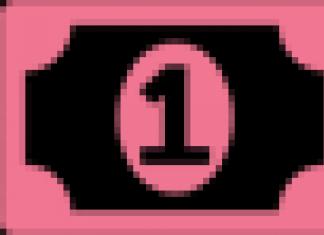How to choose a publisher? For an uninitiated person in the intricacies of publishing, it is difficult for a person to correctly navigate this issue. Especially if he is an aspiring writer, a young author who has no experience of dealing with the sharks of the publishing business, but has a manuscript of a book and big ambitions. We will try to tell you which publishing house to choose, what first of all it is necessary to pay attention to a person who wants to publish his own book; what you need to be prepared for; what information you need to have.

A lot of companies offer publishing services today, each with its own set of functions, prices and terms. Let's conditionally divide them into four groups:
- Large and small printing houses;
- Large publishers;
- Print-on-demand publishing houses;
- Electronic publishing houses;
Primary occupation typography- printing of printed products. Any. Business cards, brochures, leaflets, banners, magazines, books - all this can be printed in the printing house in any quantity and in the shortest possible time. The algorithm of work is usually the following: you send a layout of the book to the printing house, after a while you pick up the circulation. On rare occasions, some printers take care of the prepress of a book. That is, if you do not have a layout, but only have text typed on a computer, they will lay out it for you, design it, and provide it with a cover. In this case, you will pay not only for the printing of the circulation, but also for the design of the layout of the book.
What to look for when working with typography?
- large printing houses work with large print runs of books, twenty copies cannot be ordered there;
- prepress (layout of the book layout) for a large printing house is not the main function, therefore, there may be a loss in quality;
- the printing houses do not deal with the design of the publishing package. And this is a very important stage in the publication of the book;
- typographers will not thoroughly check the errors of the book and pay attention to the content; Imagine: you receive a circulation, open the book with joyful trepidation, and on the very first page you see an error! ... more! and more! .. Have you checked the errors before sending the layout to the printing house? It's a pity - all the work is down the drain, plus the money wasted. A book with errors will not be sold by any self-respecting store. Accordingly, the circulation of your book will decorate only your bookshelf. Even giving a friend such a book would be embarrassing.
1. Try to do as many prepress works as possible (by yourself or in a publishing house), and then go to the printing house and print the circulation. This is the best way to work on a book;
2. Think over what the circulation will be (how many books do you need to print?), Now call several printing houses, compare terms, prices, and then place an order.
Large publishing houses are mega-companies with a large number of authors, famous and not so famous. These publishers work mainly with well-known authors or with those whose books promise commercial success. It's not so easy to fall into this clip. How to offer yourself to a large publishing house? Write a good book. Better prose, novel (since, for example, poetry, fairy tales, children's literature will not be accepted for consideration). Handwritten text must be properly formatted - each publisher has its own rules for accepting manuscripts.
Be patient. A rather long period will pass before the author may ask whether his book will see the light of day or not. Typically, manuscripts are reviewed by editors of major publishers for 4-7 months. You should not wait passively, periodically you need to call, write and ask, persistently seeking the earliest consideration of the manuscript. One important point. Have you ever heard the phrase: "Manuscripts are not reviewed and not returned"? This means that the manuscript will not be sent back to you and they will not explain why your text did not fit. You shouldn't blame the editors who get rid of the manuscripts without explaining the reasons, they have too much work, and the review of the material is work that no one will do without payment.
If the manuscript is suitable and the publisher is ready to get down to work, the author will be informed. Cooperation begins with the conclusion of an agreement, where all the conditions for the release of the book in circulation, the budget for the future book, and the author's fee must be clearly stated. Feel free to ask questions when discussing contractual terms. Typically, large publishers conclude an agreement with the authors on the transfer of exclusive rights to the material. That is, after the document is signed, the publisher will become the owner of the manuscript, and it will be almost impossible to somehow influence the publishing process, selling the book. After transferring the rights to the book, absolutely everything can be changed: title, cover, illustrations. Consider these points at the very first stage and do not rush to sign the contract.
- Critically evaluate your material: are you sure that it will be of interest to a major publisher? The book should be of commercial interest, that is, it should sell well in the long term.
- Check the volume of the material, for example, a work of art must contain at least eight copyright sheets.
- Be persistent in submitting your manuscript to publishers, do not be shy.
Another type of publishing houses - print-on-demand publishers... These are smaller in caliber, but also more democratic.
Who can benefit from printing on demand?
- Authors who need a presentation run for their first "test ball" in the writing field;
- lovers of rare books that exist in a single copy;
- for writers - for additional printing of an already sold-out edition;
- online stores selling e-books to be able to quickly release the required number of printed books;
- individual customers. For those who want to have their biography on the shelf, or an exclusive cookbook, or a photo album published in ten copies dedicated to their son's wedding;
- teachers, authors of educational courses who produce manuals, teaching materials for their students;
Print on demand or "print on demand" (PoD) - has existed not so long ago, but it has firmly conquered the market and is confidently replacing the traditional types of book publishing. It is not difficult to understand what PoD is. This is the production of printed materials (books, magazines) in small editions. That is, you need to print exactly as much as the customer needs (as much as needed - hence the name). PoD publishers collaborate with almost all authors. Refusal is possible only if the materials can damage the reputation of the publisher. Print on demand is beneficial for publishers: there is no risk of overproduction, there is no need to stockpile products, the publisher need not be afraid that he will have an unclaimed circulation on his hands.
Printing on demand is no less advantageous for novice writers. PoD technology helps young authors publish, print and sell their books with ease. PoD publishers often go for unknown writers. It usually happens like this: the PoD publisher finds an interesting writer, brings him to the publishing market, and a large publisher promotes the author, making him a brand.
- Be sure to conclude an agreement where the terms and details of the services provided will be spelled out - this rule is mandatory for working with any publishing house.
- Keep in mind: most of the publishing work for a book is prepress. Do more yourself - pay less at the publisher.
- Don't skimp on proofreading. A book needs a good proofreader more than beautiful illustrations.
There is a common misconception: "A good writer won't get published for money." This is said by those who have no idea how the publishing business is organized in the West (which we are slowly catching up with). 95% of modern writers "entered" the bookselling market and gained popularity and popularity thanks to Print on demand technology. This is objective data.
I also heard the incorrect opinion that print on demand is the same as samizdat. It's not like that at all. Samizdat is now more correct to call electronic publishing houses(e-books self-publishing), using which the author can independently publish his book. To do this, he will need an Internet-connected computer and a book file in DOC or DOCX format. Layout, illustrations, cover - the writer does everything himself and some of them do it perfectly. One of the most famous online publishers is Lulu.com. Everything that exists now on the samizdat market in Russia is either its copies or its representatives. Samizdat is not a shame, it is modern and exciting.
So what's a budding writer to do? Which publisher should you choose?
- A large publisher whose name is on every third book?
- A print-on-demand publisher?
- Or go to samizdat - an electronic publishing house?
Everyone chooses what suits him personally. In the first case, it is important to assess the size of your talent: a large publisher will not be interested in a mediocre text. In the second, you need to correctly calculate your financial capabilities (printing on demand costs money and may not pay off). In the third case, you need, at least, to be familiar with some computer programs and to imagine the further purpose of the actions being taken.
- We are reviewing ALL manuscripts. We will not "wrap up" your manuscript without intelligible comments, but, at least, explain the reason for the refusal.
- We are publishing professionals, the work will be done at the highest level. The performance of the work is sealed by an official Contract. When you start samizdat, you will be responsible for your mistakes and to yourself.
- At each stage of the publication of the book, you control the process in detail, literally everything is coordinated with you: from the font to the cover.
- Using the services of our publishing house, you get a pass to the publishing world, to the shelves of the largest electronic stores, to bookselling networks. After that, it will be much easier for you to declare yourself as an independent figure in the writing crowd.
![]()
- How to publish your book?
- Do publishers take books from outside, it is impossible to get there?
- How can I find the contacts of all editors of all publishers to explain that my book must be printed?
Such questions are often asked by aspiring writers who have written their first novel or novella. Let's see together how you can offer your book for publication. On the websites of many publishers there are special sections devoted to working with new authors, although it can be quite difficult to find them. Still, the site is the fastest and easiest way to submit your manuscript. We have made a selection of pages for authors to make it easier for you to navigate and better build communications with editorial staff.
Always carefully read the description of the genres and formats to be considered. Usually this is indicated on the page itself, but you can also focus on the list of published books. For example, it makes no sense to send a collection of poems to someone who specializes in historical publications or science fiction. Always remember that an incorrectly executed application or letter to the editor will ensure that your work will not even be opened, so pay special attention to meeting all requirements for the text and accompanying materials.
We've compiled a selection of links to publishers working in a variety of genres to give you an idea of exactly what editors want from you.
![]() The most complete description of the requirements for texts and their design is available on the website of the EKSMO publishing house. The procedure for considering a manuscript, requirements for the design of materials, and an e-mail address for sending a completed application are described. Study all released series carefully. Only in them can your book be printed, no one will open a new one specially for you. This means that if you do not see a suitable series for your manuscript, the editors will also not be able to determine the format of your manuscript and it will not be reviewed.
The most complete description of the requirements for texts and their design is available on the website of the EKSMO publishing house. The procedure for considering a manuscript, requirements for the design of materials, and an e-mail address for sending a completed application are described. Study all released series carefully. Only in them can your book be printed, no one will open a new one specially for you. This means that if you do not see a suitable series for your manuscript, the editors will also not be able to determine the format of your manuscript and it will not be reviewed.

There are many useful materials on the website of the publishing house MYTH. Including about the economics of publishing a book and answers to questions from aspiring writers. It is proposed to send an application through the form on the page for authors, however, all contacts of employees are not difficult to find on the site. Initially, the MYTH produced only business literature, but now the publishing portfolio has been expanded with other nonfiction literature formats.
 Alpha-book publishing house specializes in science fiction and fantasy. The clear requirements for the application and the genre of the text are described. The manuscript must be accompanied by a synopsis describing the content of the book. You can also familiarize yourself with the main series, of which there are not so many, so it is extremely important that your work is in the format of one of them.
Alpha-book publishing house specializes in science fiction and fantasy. The clear requirements for the application and the genre of the text are described. The manuscript must be accompanied by a synopsis describing the content of the book. You can also familiarize yourself with the main series, of which there are not so many, so it is extremely important that your work is in the format of one of them.
 Peter Publishing House invites authors to download and fill out the book prospectus and send it to one of the editions on their own. The page also contains all the contacts and addresses of its regional offices. Please note that the main focus is educational and educational literature.
Peter Publishing House invites authors to download and fill out the book prospectus and send it to one of the editions on their own. The page also contains all the contacts and addresses of its regional offices. Please note that the main focus is educational and educational literature.
We have cited only a few publishers as an example. Perhaps something else will suit you. But the most important thing that we wanted to show is that the editorial offices are looking for new authors, but at the same time it is necessary to accept the conditions under which your manuscript will be considered.
All editions have very similar requirements for the design of the application and the principles of its consideration. Once again, I would like to draw your attention to the fact that in addition to the text of the work itself at the time of sending, it is better to have a written synopsis, an understanding of the genre, as well as an idea of the series of publishers where your work can be published.
All publishers also admit that it is extremely difficult for novice authors to get into print. Very difficult. But probably. Maybe you will be lucky.
Here is a selection of publishers that are sure to come in handy for the authors of children's literature. In the selection you will find publishers that are currently interested exclusively in children's books. But there are others on the blog, which, among other things, can publish children's books.
Melik-Pashaev- there is no specific information about cooperation. But the contact address for the authors is indicated, and they also warn that they only respond if the book interested them. The publishing house primarily publishes children's picture books, so good illustrations are just as important to them as the text itself.



Thank you for your interest in the Pink Giraffe Children's Publishing House. Like any publishing house, we are interested in new authors and will be happy to consider your manuscripts, as well as samples of illustrations and translations of a literary text, if they correspond to our subject matter and are designed in accordance with our requirements.
Please remember that ...
- manuscripts and samples not returned or reviewed.
- originals of illustrations and layouts not accepted, and the publisher is not responsible for sent and lost originals;
- handwritten manuscripts, not accepted;
- the term for consideration of manuscripts is from 1 to 3 months; if after this period we have not contacted you, then the work not accepted;
- the terms of publication are discussed only after the approval of the work;
- accepted manuscripts sent to other publishers, but we ask you to inform us about it; We also ask you to inform us immediately if your manuscript is accepted for publication by another publisher during its review by the Pink Giraffe.
Where to send your paper manuscript?
Send paper materials by mail: Moscow, 125167, 4th st. March 8, 6A, Children's publishing house "Pink Giraffe"
Where to send the electronic manuscript?
The text, in the form of a file in .doc or .jpg format for illustrations, should be sent by e-mail: (in the subject of the message, indicate "To the department of manuscripts").
Registration rules
Transmittal letter. A mandatory cover letter with your name, address, phone number, or email (website) address.
Prose and examples of literary translation. At least three chapters of text (for printed manuscripts - no more than 75 pages). The text is formatted:
- typeface size 12, font Times New Roman;
- one and a half intervals;
- the first page contains the name of the author (translator) and phone number or e-mail address.
Poetry. The entire collection or the first 10-15 poems; headset 12.
Illustrations and layouts. Photocopies, photographs, etc. are accepted. illustrations and layouts, in different styles, genres and techniques, giving an idea of the artistic range of the author. On each sample, include your first and last name, as well as your phone number or email (website) address.
Manuscripts with illustrations. Manuscripts with ready-made illustrations are accepted, but we may be interested in one thing. If text and illustrations are inseparable, please indicate this in your cover letter. Also indicate if the text and illustrations can be purchased separately, or that illustrations are given only to clarify the text (and vice versa, the text is given to clarify the illustrations).
Manuscripts are often rejected for reasons unrelated to the quality of the text. This may be an excess of works of this genre, the presence of several one-sided texts, financial reasons, etc. Unfortunately, we are not able to answer every personal letter. The standard response form does not mean that your manuscript has not received sufficient attention. This is simply the only way for us to respond to you within a reasonable time frame.
Sincerely,
Editorial staff of the Children's Publishing House "Pink Giraffe"



































